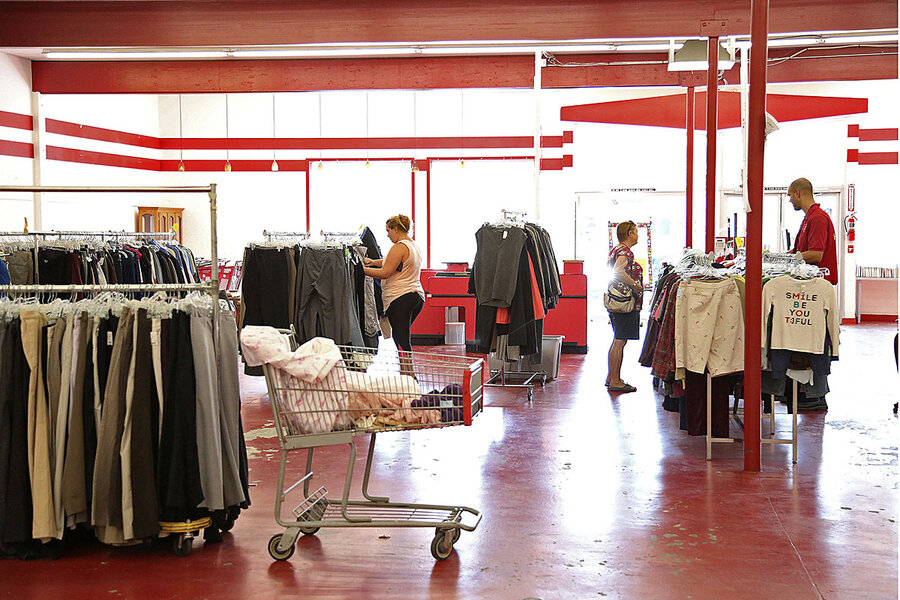Why Salvation Army is shuttering some ‘last chance’ rehab centers
Loading...
| Sacramento, Calif.
Most residential treatment facilities for drug and alcohol addiction limit stays to 15 to 30 days. The Salvation Army’s six-month program provides a chance for participants to decelerate for long enough to rediscover a purpose greater than chasing the next high.
But finding a long-term treatment program has grown more difficult in recent months with the closing of several Salvation Army rehab centers across the country. The moves come as the organization retrenches and shuts down dozens of its signature thrift stores that generate most of the funding for its rehab facilities and other programs. The growth of secondhand stores, driven by millennial and Generation Z shoppers looking to save money and spare the planet, has crowded the retail niche that the Salvation Army and Goodwill Industries once dominated.
“In the broad scope of recovery, the longer and more intensive the program, the better you do,” says George Koob, director of the National Institute on Alcohol Abuse and Alcoholism. “Many Americans think the recovery period from alcohol use disorder – and addiction in general – is 28 days. But that’s just the beginning for any treatment.”
Why We Wrote This
Nationally, long-term drug treatment programs like the Salvation Army's are especially valued, and scarce. Could a crowded thrift-shop retail niche be imperiling the charity's mission?
Michael Oliver describes the slow-motion collapse of his life from heroin addiction with dark humor. “Looking back,” he says, “it’s pretty much like a country song.”
He lost his home, his job, and his car. He stole from family, friends, and strangers. He spent brief stints behind bars and long stretches on the streets. Over the years, he tried to detox a time or two and made countless promises to himself and others to get clean. Heroin always won.
The soundtrack of misery stopped last year as Mr. Oliver faced a return to jail on home invasion and burglary charges. Seeking to show the court he could change, he enrolled in a recovery program at a Salvation Army adult rehabilitation center in Southern California.
Why We Wrote This
Nationally, long-term drug treatment programs like the Salvation Army's are especially valued, and scarce. Could a crowded thrift-shop retail niche be imperiling the charity's mission?
Most residential treatment facilities for drug and alcohol addiction limit stays to 15 to 30 days. The Salvation Army’s six-month program provides a chance for participants to decelerate for long enough to rediscover a purpose greater than chasing the next high.
“The process builds your character,” says Mr. Oliver, who “graduated” from the center in February. He now works as a residential manager at another Salvation Army facility in the region while he repairs bonds with loved ones. “You can remember who you were before drugs took over everything.”
But finding a long-term treatment program has grown more difficult in recent months with the closing of several Salvation Army rehab centers across the country. The moves come as the organization retrenches and shuts down dozens of its signature thrift stores, which generate most of the funding for its rehab facilities and other programs.
Officials with the Christian charity attribute the restructuring to rising operating expenses and slumping thrift shop revenues. In the West, the Salvation Army has closed rehab centers in Portland, Oregon; Sacramento, California; and Tucson, Arizona. The loss of the facilities occurs as the need for addiction treatment remains high: federal data show that only 3.7 million out of 21 million people with a substance use disorder received care last year.
The opioid epidemic, the resurgence of methamphetamine use, and the persistence of alcohol abuse have exposed a national shortage of residential treatment programs that last beyond 30 days. Some 80% of the country’s recovery facilities lack extended inpatient services in large part because of surging health care costs. The scarcity of such programs concerns George Koob, director of the National Institute on Alcohol Abuse and Alcoholism.
“In the broad scope of recovery, the longer and more intensive the program, the better you do,” he says. “Many Americans think the recovery period from alcohol use disorder – and addiction in general – is 28 days. But that’s just the beginning for any treatment.”
Crowded retail niche
The relative dearth of long-term residential facilities contrasts with the glut of thrift shops in large cities and small towns alike. The growth of secondhand stores, driven by millennial and Generation Z shoppers looking to save money and spare the planet, has crowded the retail niche that the Salvation Army and Goodwill Industries once dominated.
In September, the Salvation Army closed four thrift shops in and around Sacramento, along with its 90-bed rehabilitation center in the state capital. The facility’s age and lagging sales at the stores prompted officials to shut down the recovery program.
“Some of our buildings are just getting tired,” says Henry Graciani, who oversees the organization’s network of more than 100 treatment centers. “They’re old, and it would take millions of dollars to get them renovated.”
He adds that money from the sale of its facilities will enable the charity to enhance other programs. In Northern California, the organization plans to expand its 80-bed treatment center in Stockton, about an hour’s drive from Sacramento.
Mr. Graciani casts the changes as necessary to ensure that the Salvation Army can sustain the adult rehabilitation ministry it founded in 1881. In modern times, the program has earned a favorable reputation among case managers, social workers, and therapists for embracing indigent individuals spurned by other facilities.
For-profit and nonprofit rehab clinics rely on public funding, including state and federal health care programs that allow reimbursement for substance abuse treatment for low-income patients. The abundance of red tape leads to long waiting lists and has tilted recovery services toward an outpatient model to hold down costs.
The Salvation Army’s self-financed centers bypass most of the bureaucratic hurdles. The organization enrolls participants with little delay and emphasizes long-term care – two coveted program traits in California, where fewer than 5% of the estimated 2.6 million people with a substance use disorder received treatment in 2017.
“I wish we had more of those types of programs,” says Lori Miller, who manages the alcohol and drug services division of Sacramento County’s Department of Health Services. “We have a lot of people waiting for treatment.”
Mary Taylor, program manager of the King County drug diversion court in Seattle, echoes the lament. The court provides an alternative to jail for nonviolent offenders by enrolling them in recovery programs, and finding an available slot for those with the most severe drug or alcohol problems poses a constant dilemma for case managers.
The Salvation Army’s 120-bed rehab center downtown had proved a reliable option since the court’s inception in 1994. “We had a lot of people who were going there as their last chance,” Ms. Taylor says. “So it was ‘Salvation Army or bust’ – and they would end up making it.”
The charity sold the property that housed the center last month and moved the rehab program to another site with 80 fewer beds. The reduced capacity worries Ms. Taylor, given that last year King County recorded 415 alcohol- and drug-related deaths, an increase of a third from a decade ago.
“It’s a blow, for sure,” she says. Without the downtown center, “our job will be that much tougher.”
“I have a purpose again”
Research suggests that a six-month period of sobriety improves the odds of neurocognitive recovery for people coping with chronic substance use disorders. For Patricia Judd, program director of the addiction recovery and treatment program at the University of California, San Diego, the studies confirm what she has observed in her clinical work.
“Ninety days is the minimum people need to clear the brain and see the world – and their place in it – in a new way,” she says. “They need that length of stay to figure out who they are.”
The Salvation Army’s rehab centers offer an array of supportive services in addition to substance abuse treatment. Residents receive job training, housing assistance, and financial planning guidance.
The inclusion of religious services and Christian teachings in the charity’s recovery model creates wariness among some advocates and potential participants. Yet Ms. Taylor points out that the doubts tend to fall away for a person appearing before a judge.
“When people are in custody and they could be going to jail, it can change their perspective,” she says. “And the Salvation Army has had the ability to reach certain people that other programs couldn’t or wouldn’t.”
Mr. Oliver’s six-month stay in a Salvation Army rehab center in Southern California reversed his unwinding. He avoided jail and steep fines, and in the past several months, he has reconnected with his young son and his parents.
In his job with the charity, Mr. Oliver works with men attempting to climb out of the abyss of addiction, guiding them upward from despair and dysfunction. He knows the struggle. He gains strength from their journey.
“I feel I have a purpose again,” he says. “It’s not just a 9-to-5 job, not just a paycheck. There’s a feeling that I’m having an effect on guys. But the truth is, they help me more than I help them.”








